Which gutter is better - plastic or metal? Comparative review
The gutter system is an integral part of the roof of any building. According to the device, it is internal and external. Structurally, it includes pipes, gutters, funnels, bends, elbows and other components.
For the manufacture of these elements, different materials are used. It is difficult to choose the appropriate type of drain from the range of products offered, but do not want to overpay? Let's get together to figure out which gutter is better - plastic or metal, for which we carefully compare in the framework of this article all the characteristics of the systems offered on the market.
We will also give recommendations to potential buyers on choosing the optimal drainage system, providing the material with video tips and photo illustrations.
The content of the article:
Which is better: plastic vs metal?
It is impossible to get rid of rain and melt water by definition. Residential and non-residential buildings must somehow be protected from their effects, otherwise the walls, roof and foundation will not last long.
If there is no gutter system on the roof, then not only the exterior finish, but also its supporting structures will quickly begin to collapse. Better to spend money and make an effective drainthan then overhaul the entire building.
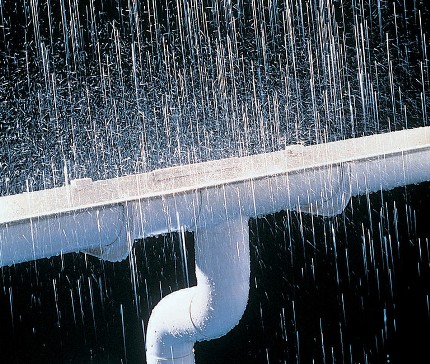
All elements of the drain according to the material of manufacture can be divided into two groups:
- metal;
- plastic.
The first group includes products from steel, copper, zinc and aluminum, and the second from PVC, polypropylene and polyethylene. And each of these materials has its own merits.
In short, galvanized or polymer-coated steel, unlike plastic, does not change its geometry in the sun and does not burst from ice freezing inside. Copper and zinc elements of the drain will last the longest, but they are also the most expensive. Plastic drains are distinguished by a variety of color solutions and low cost.
However, the choice of material for manufacturing the roof spillway system is highly dependent on the configuration of the roof, the amount of precipitation, and the average annual temperature in the region where the building was built.
Before you go to the store to purchase a drain, you must study all the nuances of the proposed options. In some cases, you can do with inexpensive plastic, while in others it is better to take something from metal.
Features of metal systems
Gutters used to be made of zinc and copper. However, the first metal was too susceptible to corrosion and short-lived, and the second - very expensive. Zinc, if now used, is only in the form of an alloy with titanium. More often it is used simply for galvanizing steel.
It is galvanized steel gutters and pipes that are mostly offered by sellers when a buyer asks to show a metal drain.
Material # 1: Galvanized
Steel products are the most affordable version of a metal drain. They are made of cold rolled steel, which is coated with a layer of zinc.
Such eastern systems have a long service life (if the zinc coating is not damaged), resistance to UV and temperature extremes. They can withstand large volumes of snow without breaking without breaking in the winter.
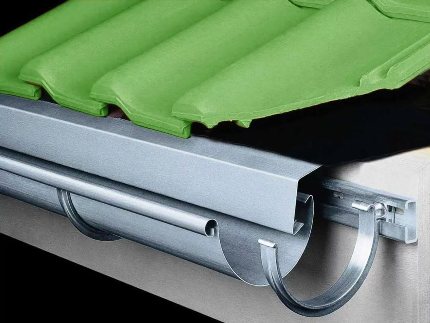
To give the gutter structure a more presentable appearance and increase the service life, galvanization is coated with polymers:
- Pural (PUR);
- plastisol (PVC, PVC);
- polyester (PE or MPE).
Pural coating is resistant to mechanical damage, ultraviolet and belongs to the middle price segment. A steel gutter with it will last 30–35 years without replacement.
Plastisol (polyvinyl chloride) is distinguished by a wide range of color solutions and low cost. However, under the influence of UV rays, it softens and deforms. Its service life is up to half a century, but not in the southern regions with high insolation.
Regular polyester (PE) is cheap, it easily tolerates ultraviolet radiation, but it is easily scratched even by ice. This coating will last 10-15 years. Then the protection will disappear, and moisture will begin to destroy the steel base. It has a more durable analogue with the addition of Teflon - MPE. However, unlike PE, this color option is limited only by shades of gray.
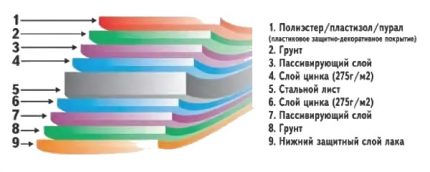
If the roof is metal, then the elements of the eastern system are best chosen from a similar material with an identical multilayer structure. So the life expectancy before repair they will have a common, the replacement of the roof and drains can be made subsequently together at the same time.
Material # 2: Aluminum Zinc (Galvalyum)
Galvalyum is called steel coated with an alloy of aluminum and zinc (Al + Zn) with the addition of silicon. This material surpasses conventional galvanization by several times in heat resistance, coating strength and its corrosion resistance. He is not afraid of acid rain and ultraviolet light.
And to get a scratch on it, you have to try hard. Snow and ice are not able to harm him.
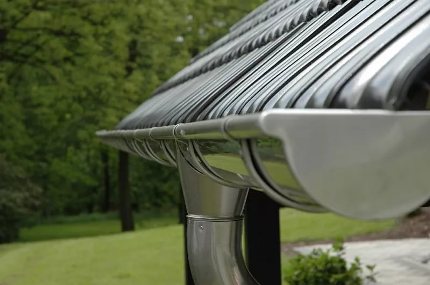
Zinc has a higher electrochemical potential compared to iron. As a result, it gradually “dissolves”, leveling only the oxides that begin to form on steel. Corrosion simply cannot get through such a protective layer to the base metal.
Material # 3: Titanium Zinc
This alloy is also inherent in high rates of corrosion resistance and strength. It consists of titanium, copper and zinc. The first metal is responsible for reducing the susceptibility to corrosion, the second for ductility, and the third serves as the basis.
These metal gutters can be mounted on roofs of any shape, they bend without problems, without breaking.
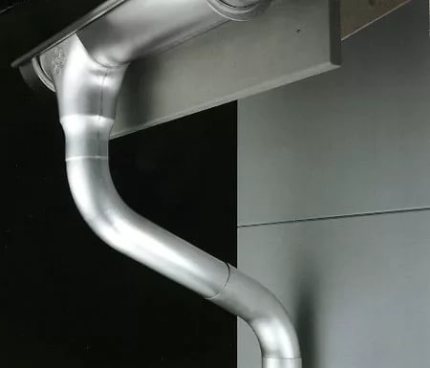
Water is not afraid of titanium-zinc, it is an ideal alloy for the construction of drains. Its main problem is susceptibility to electrocorrosion. Contacting with copper or iron, it begins to inevitably collapse. And practically nothing can be done with this. It remains only to exclude such contact. If the roof is covered with copper sheets, then the drain is better to take from another metal.
Material # 4: Aluminum
Compared to steel, aluminum gutters are lighter and less susceptible to corrosion. The lightness of the metal allows the walls of pipes and gutters to be made thicker. At the same time, such a drainage system does not unnecessarily load the fasteners, but is able to withstand significant loads from snow, ice and water.
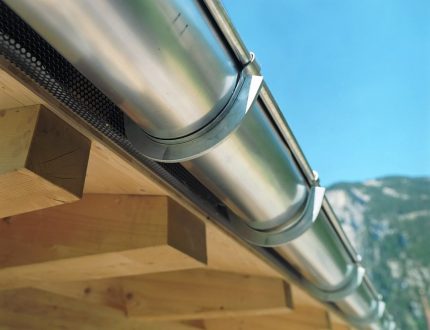
Aluminum calmly tolerates frosts, the sun and mechanical shock. It is durable, but noisy and relatively expensive. If the cottage has poor sound insulation, then every drop of rain falling into a similar drainage system will be perfectly audible inside.
Often, aluminum gutters are covered with polymer paint by manufacturers. This increases the corrosion protection and allows the product to be painted in color from the RAL catalog. For the roof of the house, you can choose the aluminum elements of the drainage system as a noble silver shade, and with any other color. In this regard, aluminum outperforms many metal competitors.
Material # 5: Copper
The copper drain is a fusion of luxury and aesthetics in the exterior of a private house. It will cost a round sum, but with proper installation it will last as long as the building itself will stand. Copper is wear-resistant, durable and does not deform in heat or cold. Scratches and a natural patina give it only elegance. And it is completely indifferent to ultraviolet.
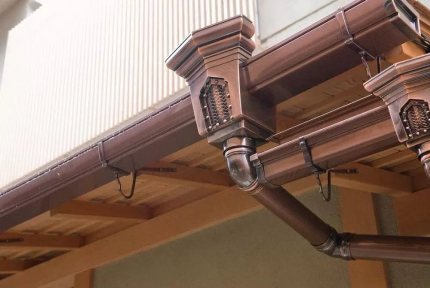
A metal gutter system made of copper reflects the refined taste of the owner of the cottage, as well as its financial viability. Such a drain is worth a lot of money. Not for nothing that all products from this metal belong to the elite class. But then the copper drainage system on the roof will certainly last more than a hundred years.
Have you decided to buy metal gutters for the roof of your house? In this case, we recommend that you detailed instructions do-it-yourself installation.
Specificity of Plastic Structures
Modern plastic products are resistant to damage and moisture, do not fade for a long time in the sun and are extremely easy to install on the roof. Plastic gutter systems are cheaper than metal. But in terms of wear resistance and a service life of 10–15 years, the former are much worse than the latter.
In stores you can find plastic gutters from:
- polyvinyl chloride (PVC);
- polypropylene;
- polyethylene.
The most popular option is PVC. It tolerates air temperatures within the range of -15 ... + 60 ° C without any problems. In the southern regions, this is quite a worthy competitor to one or another metal. But for roofs of buildings in the North, a drain from PVC is better not to take. Two other polymers become brittle during freezing and crack due to minimal external impact.
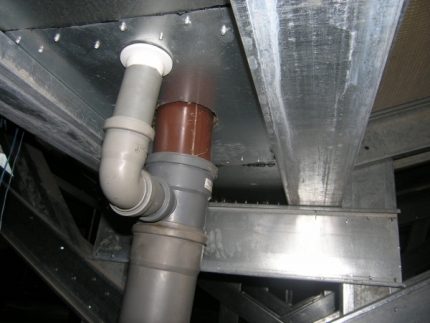
Russian climatic conditions do not shine with moderation and thermal warmth. Low frost resistance for plastic gutters is a huge minus. According to reviews, drainpipes even made of PVC in the middle lane are often torn apart from the inside by ice in winter. In this regard, the plastic can not keep up with the metal.
Plastic gutters often break in the spring under a load of snow and ice. And in the summer in the heat, they sag due to the fact that PVC softens and “floats”.
To avoid these problems, you have to install fasteners with a small step and lay heating cable. This is an additional cost, but in the case of a plastic gutter, nothing else.
However, drainage systems made of plastic have many positive aspects:
- Good sound absorption.
- Easy installation.
- Possibility of installation with any type of roofing.
- Excellent anti-corrosion properties of the material.
- Low cost - 2–3 times cheaper than a galvanized metal competitor.
- A smooth surface that does not trap foliage and other debris.
- Extensive range of colors.
By the totality of the characteristics, the plastic drain is a little behind the metal one. But if you need an inexpensive design for DIY assembly, then PVC pipes, gutters and funnels are best suited. But we must remember that in the event of a breakdown an element of the drainage system made of plastic will have to be completely replaced, it is impossible to repair it.
How to choose gutters?
The choice between plastic and metal is due to many factors. The drainage system is not something independent. It must match the material of the roof and the shape of the roof.
When choosing a drainage system, you need to focus on:
- roof slope area;
- financial opportunities;
- climatic conditions (rain and snow volumes, air temperature during the year);
- building facade design;
- laid roofing material.
If there is a chance of ice formation, then it is best to opt for a metal drain. This also applies to the situation with heavy rainfall and severe frosts. In this case, the plastic should be immediately put aside.
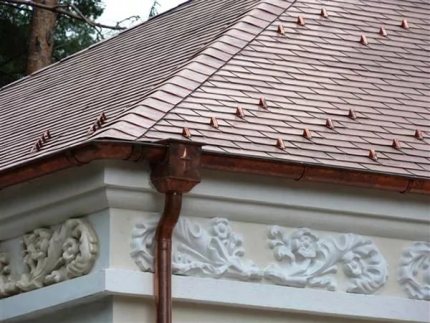
If the house is covered with metal tiles or decking, then the best choice would be a metal drain made of galvanized steel with a polymer coating to the color of the roofing material.
And for made of flexible tiles or other soft roofs, the option of plastic is more suitable. Under the slate, it is also worth taking a plastic design.
A lot when choosing a gutter depends on financial opportunities. First you need to calculate the required number of typical elements for the assembly of gutters. How to do this, we examined in next article.
If, due to a lack of funds for covering the roof, cheap materials were chosen, then it makes little sense to spend money on a drainage system from copper. This is impractical and will look ridiculous.
It is better to install plastic pipes and gutters in such a situation, and next year invest in a new roof and gutters in full.
Conclusions and useful video on the topic
The following videos will surely help you understand the question of how to correctly select the elements of a system for removing water from the roof. There are many nuances in this topic, it is better to eliminate errors in advance.
Comparison of metal and plastic gutters:
An example of drainage systems is the choice between plastic and metal construction:
An example of the manufacture of homemade gutters in the following video:
Without a drainage system, a house is doomed to destruction. Uncontrolled water flows from the roof will ruin the facade, and then destroy the foundation.
When choosing a metal or plastic gutter, you should carefully look at what plastic or metal it is made of. In both groups, there are many options with different characteristics. In some cases, galvanizing or aluminum will be optimal, and in others it will be better to purchase PVC.
Do you have practical experience in choosing and installing a drainage system and want to share it with other users? Maybe you do not agree with the theoretical information specified in the article? Or do you have a different opinion on this? Describe your view on this issue - leave your comments under our article, add a photo of your drain.

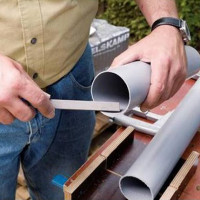 DIY roof gutters: instructions for self-manufacturing a drainage system
DIY roof gutters: instructions for self-manufacturing a drainage system 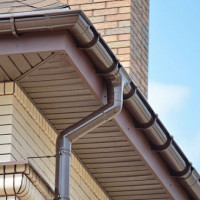 How to make spillways from the roof: general recommendations for arranging a drainage system with your own hands
How to make spillways from the roof: general recommendations for arranging a drainage system with your own hands 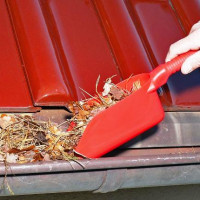 Storm sewer cleaning technology: an overview of popular ways
Storm sewer cleaning technology: an overview of popular ways 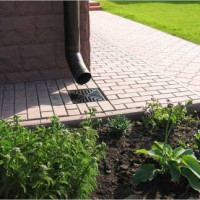 Do-it-yourself storm water drain: all about the installation of a storm shower for a summer house and a private house
Do-it-yourself storm water drain: all about the installation of a storm shower for a summer house and a private house  Calculation of storm sewers: an analysis of important design features
Calculation of storm sewers: an analysis of important design features  How much does it cost to connect gas to a private house: the price of organizing gas supply
How much does it cost to connect gas to a private house: the price of organizing gas supply  The best washing machines with dryer: model rating and customer tips
The best washing machines with dryer: model rating and customer tips  What is the color temperature of light and the nuances of choosing the temperature of the lamps to suit your needs
What is the color temperature of light and the nuances of choosing the temperature of the lamps to suit your needs  Replacement of a geyser in an apartment: replacement paperwork + basic norms and requirements
Replacement of a geyser in an apartment: replacement paperwork + basic norms and requirements
They wanted to save money, because a plastic drain was installed around the house in the village. Through winter, at a temperature of -25 degrees, it already cracked and dripped by spring. The sun began to fade. I had to throw it and remodel it on a metal with a polymer coating. More expensive, but fewer problems. Even if it bends, you can straighten it. And if you have money, then put aluminum, it looks very cool.
The roof of the house we bought was equipped with plastic drains, when I bought it somehow I didn’t pay much attention to it. In the second year, they cracked, our winters are cold. As a result, I ordered aluminum. He is not afraid of frost, can withstand all the loads, there were no problems during installation. True, it is written that noise from the rain is heard, with plastic there was no such problem. Of course, copper is the most beautiful and looks rich, but it was a pity that much money.